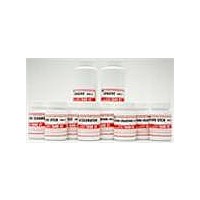41672-1L MG Chemicals, 41672-1L Datasheet - Page 2

41672-1L
Manufacturer Part Number
41672-1L
Description
Chemicals TIN ELECTROPLATING SOLUTION
Manufacturer
MG Chemicals
Datasheet
1.41672-1L.pdf
(4 pages)
Specifications of 41672-1L
Description/function
Tin Electroplating Solution
Product
Chemicals
Size
945 mL
Special Features
Tin Electroplating Solution
Weight
1 L
Lead Free Status / RoHS Status
Lead free / RoHS Compliant
Section 7: Handling and Storage
Section 8: Exposure Controls
Section 9: Physical and Chemical Properties
Section 10: Stability and Reactivity
Section 11: Toxicological Information
Handling: Wash thoroughly after handling. Avoid contact with eyes, skin, and clothing. Do not ingest or inhale.
Storage:
Routes of entry:
Ventilation:
Personal Protection: Wear appropriate protective eyeglasses or chemical safety goggles. Wear appropriate
Physical
State:
Boiling
Point:
Stability:
Conditions to avoid:
Incompatibilities:
Polymerization:
Decomposition:
Sensitization: (effects of repeated exposure)
Carcinogenicity: (risk of cancer)
Teratogenicity: (risk of malformation in an unborn fetus) Not known to
Reproductive Toxicity: (risk of sterility)
Mutangenicity: (risk of heritable genetic effects)
Lethal Exposure
Concentrations:
Stannous Sulfate
Sulfuric acid
Liquid
95°C
Keep away from sources of ignition. Store in a cool, dry, well-ventilated area, away from incompatible
substances. Keep from freezing.
Odor:
Specific
Gravity:
Sulfur dioxide and sulfur trioxide could be evolved in a hot fire.
Eyes, ingestion, inhalation, and skin.
Use adequate general or local exhaust ventilation to keep airborne concentrations below
exposure limits.
protective clothing to prevent skin contact. Wear Neoprene, butyl or natural rubber gloves.
Use a NIOSH approved respirator when necessary.
Stable at normal conditions and temperatures.
Contact with incompatible materials. Contact With Organic Materials (Such As
Isoprene, Nitrates And Picrates) May Cause Fire And Explosions.
Contact With Metals May Produce Flammable Hydrogen Gas.
Sulfides, Cyanides, strong Akalis, combustible materials, Halogens, Organic materials,
Powdered metals, Strong oxidizing agents, Strong reducing agents.
Will not occur.
May form corrosive vapors, sulfur oxides, toxic fumes
Ingestion (LD50):
5152 mg/kg Mouse
350 mg/kg rat
Alcohol Acrylonitrile, Chlorates, Carbides, Epichlorohydrin, Fulminates,
WHEN DILUTING, ADD ACID TO WATER. DO NOT ADD WATER TO ACID.
Mild Acid
1.125 @ 25°C
Inhalation (LC50):
N/E
18 mg/m3/8H guinea Pig
PAGE 2 / 4
Solubility
In water:
Vapor
Pressure:
Not known to
The International Agency for Research on Cancer (IARC)
has classified "strong inorganic acid mists containing
sulfuric acid" as a known human carcinogen, (IARC
category 1). This classification applies only to mists
containing sulfuric acid and not to sulfuric acid or sulfuric
acid solutions.
Not known to
Not known to
100%
N/E
Evaporation
Rate:
Vapor
Density:
Skin
(LD50):
N/E
N/E
Registered Quality System ISO 9001
Inhalation
(TCLo):
290 ug/m3/24H Rat
8 mg/m3/5D guinea Pig
Similar to
water
Similar to
water
Burlington, Ontario, Canada
MSDS Code: 41672
QMI Certificate #004008
pH:
<1.0



